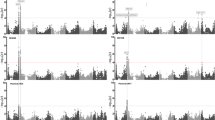Abstract
There is very limited information on genetic gains and improvement of maize inbred line performance per se that has been attained through introgression of temperate germplasm into tropical maize germplasm to enhance adaptability in target environments. The objective of this study was to determine the genetic gains for grain yield and its components achieved by introgression of temperate germplasm into tropical elite maize inbred lines. A total of 123 maize inbred lines comprising of 76 introgressed inbred lines, 21 tropical inbred lines (negative controls) and 26 temperate inbred lines (positive controls) were evaluated in an augmented design at four sites. The strategy was effective and successful to enhance grain yield, in particular, ear prolificacy. Positive genetic gains were realised for grain yield (5%) and ear prolificacy (46%) relative to the population and mean of checks. Selection for plant and ear height, root and stalk lodging had gains ranging from 2 to 11%. However, traits such as anthesis and silking days and grain moisture content at harvest had low gains. Introgressed inbred line performance per se was impressive because new inbred lines with potential for commercial production were obtained. Inbred line 71-DMLF7_88 showed combined early physiological maturity, high ear prolificacy and grain yield potential that were at par with the mean of the temperate checks. Thus, indicating an improvement in the agronomic performance of the improved tropical based material that normally performs below temperate checks in South African warm temperate environments. In conclusion, introgression of temperate germplasm into tropical elite inbred lines was effective in improving adaptation in warm temperate environments.
Similar content being viewed by others
References
Abbott L, Filippini S, Delfino H, Pistorale S (2012) Stability analysis of forage production in Bromuscatharticus (prairie grass) using three methodologies. Ciencia e Investigación Agrarian 39:331–338
Al-Tabbal JA (2012) Genetic variation, heritability, phenotypic and genotypic correlation studies for yield and yield components in promising barley genotypes. J AgricSci 4:193–210
Badu-Apraku B, Yallou CG, Oyekunle M (2013) Genetic gains from selection for high grain yield and Strigaresistance in early maturing maize cultivars of three breeding periods under Striga-infested and Striga-free environments. Field Crops Res 147:54–67
Bello OB, IgeAzeez SAMA, Afolabi MS, Abdulmaliq SY, Mahamood J (2012) Heritability and genetic advance for grain yield and its component characters in Maize (Zea mays L.). Int J Plant Res 2:138–145
Brathwaite O, Brathwaite RAI (2002) Multiple ear effects on yield of maize varieties under tropical wet anddry season conditions. Maydica 47:115–120
Ci X, Li M, Liang X, Xie Z, Zhang D, Li X, Lu Z, Ru G, Bai L, Xie C, Hao Z, Zhang S (2011) Geneticcontribution to advanced yield for maize hybrids released from 1970 to 2000 in China. Crop Sci 51:13–20
CIMMYT (1985) Managing trials and reporting data for CIMMYT's International Maize Testing Program, Mexico, D.F.
Duvick DN, Smith JSC, Cooper M (2004) Long-term selection in a commercial hybrid maize breedingprogram. Plant Breed Rev 24:109–151
Gapare WJ (2000) Predicted and realized genetic gain in Eucalyptus grandis breeding seedling orchard in Zimbabwe. Southern African Forestry J 189:1–15
Hallauer AR, Miranda JB (1988) Quantitative genetics in maize breeding, 2nd edn. Iowa State University Press, Ames
SAS Institute Inc., (2010). SAS software. SAS Software release 9.3. Cary, NC: SAS Institute Inc. NC, USA
Kesomkeaw P, Lertrait K, Suriham B (2009) Response to four cycles of mass selection for prolificacy at low and high population densities in small ear waxy corn. Asian J Plant Sci 8(6):425
Lin CS, Poushinsky G (1983) A modified augmented design for an early stage of plant selection involving a large number of test lines without replication. Biometrics 39:553–561
Morris ML (1998) Maize seed Industries in developing countries. CIMMYT Mexico, Mexico, D. F.
Scott RA, Milliken GA (1993) A SAS program for analysing augmented randomized complete block designs. Crop Sci 33:865–867
Singh BD (2006) Plant breeding: principles and methods. Kalyani Publishers, New Delhi, India
Singh RK, Chaudhary BD (2004) Biometrical methods in quantitative genetic analysis. Kalyani Publishers, New Delhi, India
Souza ARR, Miranda GV, Pereira MG, de Souza LV (2009) Predicting the genetic gain in the Brazilian white maize landrace. Ciência Rural 39:19–24
Spehar CR (1994) Field screening of soya bean (Glycine max (L.) Merrill) germplasm for aluminum tolerance by the use of augmented design. Euphytica 76:203–213
Svecnjak Z, Varga B, Butorac J (2006) Yield components of apical and sub apical ear contributing to the grain yield responses of prolific maize at high and low plant populations. J Agron Crop Sci 192:37–42
Uhr DV, Goodman MM (1995) Temperate Maize inbreds derived from tropical germplasm: II. Inbred Yield Trials Crop Sci 35:785–790
Varga B, Svecnjak Z, Knezevic M, Grbesa D (2004) Performance of prolific and nonprolific maize hybrids under reduced-input and high-input cropping systems. Field Crop Res 90:203–212
Weng YH, Tosh K, Adam G, Fullarton MS, Norfolk C, Park YS (2008) Realised genetic gains observed in a first-generation seedling seed orchard for jack pine in New Brunswick. New Forests, Canada
Acknowledgements
I would like to take this opportunity to express my sincere gratitude to Seed Co International for all financial support. I am also obliged to staff members of Seed Co Ltd, University of KwaZulu-Natal administrative team. Most importantly, the equal contribution of all the authors involved in this study and the personnel involved in preparing the final manuscript.
Author information
Authors and Affiliations
Corresponding author
Additional information
Publisher's Note
Springer Nature remains neutral with regard to jurisdictional claims in published maps and institutional affiliations.
Appendices
Appendix 1
See Table
Appendix 2
See Table
Appendix 3
See Table
Appendix 4
See Table
Rights and permissions
About this article
Cite this article
Musundire, L., Derera, J., Dari, S. et al. Assessment of genetic gains from introgression of temperate genes into tropical elite maize inbred lines: I. performance per se. Euphytica 217, 39 (2021). https://doi.org/10.1007/s10681-021-02773-4
Received:
Accepted:
Published:
DOI: https://doi.org/10.1007/s10681-021-02773-4




